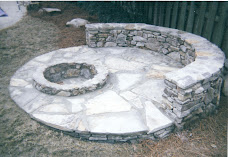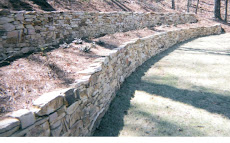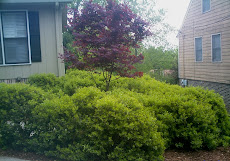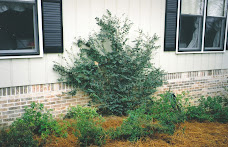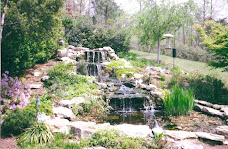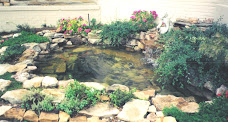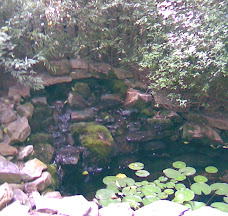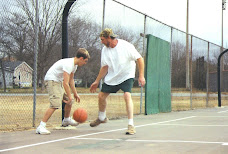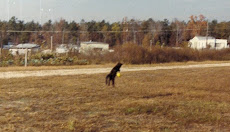Happy Birthday to Marge!
She is a great plant person with a fantastic collection of indoor plants and an awesome looking deck with patio plants and flowers galore. She really does have a green thumb and seems to have a special connection with the plants she grows. As a great grandmother, Marge is very active and I have to think that being around plants and working with them is one way she's accomplished this. You've always been an inspiration to me and a joy to be around.
Saturday, April 26, 2008
Posted by
themanfromearth
at
3:03 PM
0
comments
![]()
Tuesday, April 15, 2008
A brisk, sunny day in Vestavia, Alabama
A very nice couple and long time clients of mine allowed me to plant some of my favorite plants for them a few years back. Today, I stopped by to do some pruning and thought I'd take some pictures of a few of the plants that were looking especially nice. 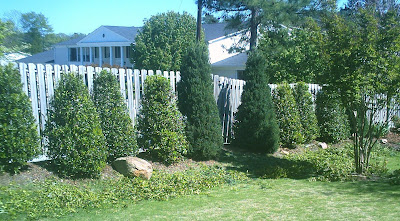
When it comes to pruning, I try to make my cuts in such a way as to promote the health and looks of the plant. I'm a big believer in hand pruning (with my trusty Felco pruners) as opposed to using shears, electric or otherwise, because you have so much more flexibility. If you are trying to get a natural looking pruning job when pruning Hydrangeas, for instance, shears are just not going to get the desired effect. Even with hollies such as these Needlepoint hollies in the picturee above, using hand pruners allows you to make cuts deeper inside the plant while still maintaining a manicured look, if that is the desired result as it was with these. And as always, I do my best to prune in such a way as to have plants such as these stay bushy all the way to the ground. This is what you want when pruning plants along your foundation or fence. Much of the same principles go for the pruning I did on the Green Robusta junipers, as well, except fot the exception of making deep cuts. With almost all conifers, such as cypresses, cedars, and junipers, you've got to be careful not to prune into wood that is too thick. They just don't respond well to heavy pruning.
OK, enough on pruning! Here are a few plants at this Vestavia home that I thought you might enjoy seeing:
Green lace-leaf Japanese maple. I planted this plant about 5 years ago. As I remember, it was a two gallon plant and was probably no more than 2' tall by 2' wide when I planted it. It is slow growing, but has managed to grow nearly 4' tall by 6' wide. Red varieties of Japanese maples get all the love at the local nurseries, but the green fellas have a lot to offer, as well, including outstanding fall color and a nice contrast to other plants such as these Parson junipers that are planted around it. 
Lady Banks rose is a thorn less rose that is well suited for trellises and training on walls. The garage door was such a big part of the front of this home that we felt something growing up and over it would help provide a soft effect. Lady Banks rose only blooms once a year, in the spring, but the flower show lasts for a good three or four weeks and the plant is evergreen. Another good reason to consider it. The homeowner has done a very good job of keeping it growing over the garage doors (in this case, with masonry nails and ties) and it requires some pruning of limbs when they hang too low. Lady Banks rose is available in yellow and white blooming forms. 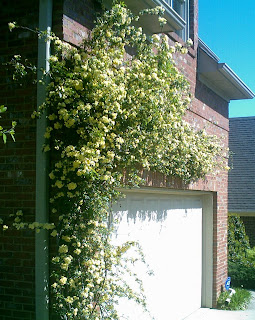
And finally, the ol' standby for what to use as a small tree in a small yard has to be Bloodgood Japanese maple. When I planted this tree five years ago, it was probably about four or five feet tall with limited branching. One key to the success of any tree planted in a turf situation is to create a mulch ring or mulched natural area around the tree which eliminates mower or weed trimmer damage. As far as pruning goes, I occasionally remove lower branches so mowing isn't a hassle and to allow light to the grass below. There are lots and lots of worthy upright red Japanese maple varieties to chose from and Bloodgood is certainly the grand daddy of them all and continues to be a great choice for the landscape. 
Posted by
themanfromearth
at
4:29 PM
2
comments
![]()
Labels: evergreen landscape plants, pruning, trees
Thursday, April 10, 2008
Once a year

Once a year, this special plant, a gift from my friends Joe and Ann, blooms without fail. The plant is tropical, so I keep it inside during the winter. The blooms are awesome and the show will last several weeks. I thought I'd share the beauty of this plant to all visitors. I hope you enjoy it! Of course, Joe and Ann told me what kind of plant this is, but I am suddenly afflicted with memory loss. When I find out, I'll let you know. Or better yet, does anyone know what it is?
UPDATE: I have had correspondance with Joe and Ann! Ann says the plant is called Clivia. I knew that! After doing a little research, I'm finding that there is a cult of Clivia lovers all over the world. Clivia is considered a prized indoor plant and valued for it's beautiful blooms. While the orange flowering variety is most common, there are yellow and even pink blooming Clivia plants, as well.
Posted by
themanfromearth
at
6:23 PM
0
comments
![]()
Labels: Rob's musings
Friday, April 4, 2008
Mortar-less rock wall
 Last November, I constructed a rock wall for some very nice folks in Homewood. They were initially considering a wall made from one of those segmental retaining wall systems....like Keystone, Geostone, etc. One advantage of using those is that they are, genreally, easy to erect and they need no mortar. The material is not cheap (relative to other materials), though, and the look is, how should I say,,,not very organic. I convinced my clients to give natural stone a try and they have told me they are happy they made the choice.
Last November, I constructed a rock wall for some very nice folks in Homewood. They were initially considering a wall made from one of those segmental retaining wall systems....like Keystone, Geostone, etc. One advantage of using those is that they are, genreally, easy to erect and they need no mortar. The material is not cheap (relative to other materials), though, and the look is, how should I say,,,not very organic. I convinced my clients to give natural stone a try and they have told me they are happy they made the choice. 
Constructing a mortar-less stone wall that is over 3 or 4 feet tall requires some careful considerations. For one, the amount of loose backfill to be placed behind the wall plays into the size of the stone chosen. By the way, we decided to use a brown rubble stack stone for this project. Most of the stone I used for this wall was three to six inches thick by ten to eighteen inches long by eight to twelve inches deep (some deeper for extra security). Sidenote: When I call my stone provider, I like to throw them a loop and ask for stone that is the size of something off the wall, such as a brief case or a toaster or a mail box. I usually get an uncomfortable pause (no telling what they're thinking!), so I always give them some actual measurements, too. 
The basics of wall building come into play and must be adhered to, also. They include preparation of a foundation, including several inches of gravel base; backfilling with gravel; baffling the stone as the wall is being built. Other things, such as parallel placement of the stone, securing the top of the wall with substantial stone pieces, and creating pleasing lines when designing the wall are important. 
Finally, the finished product achieved my clients objectives. It helped to create a level area for their son to play on and it added positively to the overall appearance of their backyard.
ps...You can click on any picture that is included as part of one of my posts to get a larger view.
Posted by
themanfromearth
at
1:05 PM
2
comments
![]()
Labels: project showcases, stone work, walls
Tuesday, April 1, 2008
The Legend of Sasqwood
Somewhere in the tiny town of Alabaster, AL, a woody creature lurks. The legend and folklore is alleged by many, known by few, but spoken of by none. Until now. Call me crazy? If not for these undoctored photos I took one late March afternoon in the year 2008, I suppose I'd call myself and my claims crazy too!
I first noticed the ellusive beast as he wandered past some potted plants in my back yard. Do you see him (or her, I don't know?) resting next to my rosemary plant?
He tried to run away, but the unexpected fencing stopped him in his tracks. Suddenly, he was faced with a decision: Be caught or run for the cover of a corner foundation shrub!
I decided that I should lay back and allow this barked creature to calm down, so I waited a few minutes before continuing my pursiut. That is when I found him hiding in this American holly. 
My strategy paid off as Sasgwood began acting as if no one was there. I even caught a rare glimpse of him grazing on some wax ligustrum leaves.
Suddenly, this amazing beast heard the click of my camera and became alarmed. I ran after him to no avail as he was just too fast for me. My last snapshot is a blurry one of Sasqswood running with abandon across my backyard into some surrounding woods filled with the cover of native azaleas and hydrangea. 
Will this wonderfully woody creature find his way back into close proximity of this population of human lifeforms? I'll be waiting with camera in hand, if he does.
Posted by
themanfromearth
at
7:12 PM
1 comments
![]()
Labels: Rob's musings
